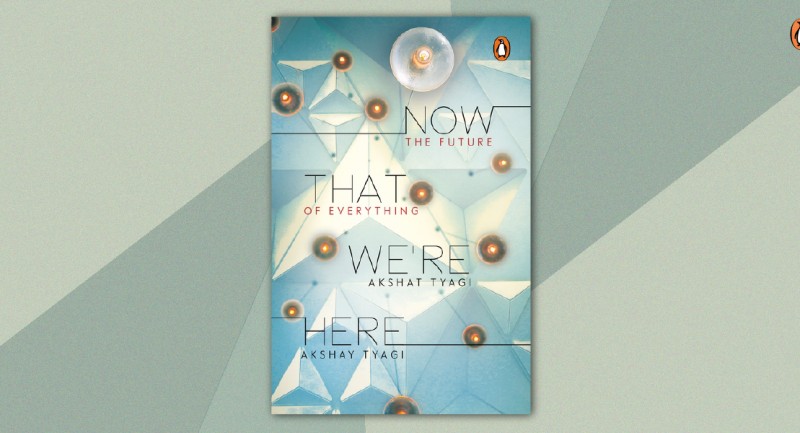
In his new book, A Human’s Guide to Machine Intelligence, Kartik Hosanagar surveys the brave new world of algorithmic decision making and reveals the potentially dangerous biases to which they can give rise as they increasingly run our lives. He makes the compelling case that we need to arm ourselves with a better, deeper, more nuanced understanding of the phenomenon of algorithmic thinking. The way to achieving that is understanding that algorithms often think a lot like their creators-that is, like you and me.
Here is what the author has to say about his journey towards writing the book!
Tell us what your book is about.
If you read the news, you have probably heard the term algorithms: computer code that seem to control much of what we do on the internet, and which are landing us in all sorts of jams. Elections are swayed by newsfeed algorithms, markets are manipulated by trading algorithms, women and minorities are discriminated against by resume screening algorithms — individuals are left at the mercy of machines. There is a lot of fear mongering and we hear terms such as “weapons of math destruction.” But a key question remains unanswered: what are we supposed to do about it? We can’t wish algorithms away – and, frankly, we wouldn’t want to. But they come with huge implications to our personal and professional lives that we need to understand if we’re going to attempt to offset the challenges they pose. This book offers us a way in.
Why did you write this book?
I spend my days helping students understand technology; designing and analyzing studies that probe algorithms’ impact on the world; and writing code myself. And while my subject gets a lot of attention in popular journalism, I feel the public lacks the right mental models to understand algorithms and AI, and as a result the conversation is too fear-oriented, at the expense of being solution-oriented. This is my attempt to address these problems and start a conversation on what the solution should look like.
The germ of the book itself began in my research lab. I was conducting a study I thought would confirm accepted notions that the Internet was democratizing taste and choice; in fact, it showed that commonly used algorithms did the opposite. That led me to work on how to design systems to achieve better social goals and business targets. We need to do something similar here, with this broader challenge – take a forward-looking view to solve the problems, not just worry or create fear about them.
Are algorithms too complex for most of us to understand?
They are not. Many of us are overwhelmed when we hear words like algorithms and AI. But they are concepts all of us can understand and, in fact, need to understand given their growing importance.
Today’s most sophisticated algorithms aren’t simple sets of instructions; they’re black boxes too technical for most of us to get our heads around. Even the regulators trained to monitor these things are years behind the AI that underlies modern algorithms. That’s what this book offers: a way in. In the course of trying to explain why code goes rogue, I came upon a novel insight that offers not only an understanding of algorithms, but points us towards a framework for controlling their power. I found that algorithmic behavior, like human behavior, can be influenced by both nature and nurture – in algorithms’ case, this means how they are coded by their programmers and the real-world data they soak up and learn from. In other words, algorithms go rogue for some of the same reasons humans do: they’re creative and unpredictable, they’re usually wonderful, sometimes dangerous.
This way of viewing algorithms helps us understand what causes algorithms to behave in biased and unpredictable ways, and in turn helps move us away from a fear-driven conversation towards practical solutions to these problems.
So, how concerned should we be that AI and algorithms have biases?
The biggest cause for concern is not that algorithms have biases; in fact, algorithms are on average less biased than humans. The issue is that we are more susceptible to biases in algorithms than in humans. First, despite our emerging skepticism, most people still see algorithms as rational, infallible machines, and thus fail to address and curb their (so-called) “bad behavior” quickly enough. So, elections are swayed, markets are manipulated, individuals are hurt due to our own attitudes and actions towards algorithms. Moreover, human biases and rogue behaviors don’t scale the way rogue software might. A bad judge or doctor can affect the lives of thousands of people; bad code can, and does, affect the lives of billions. So I finish the book by proposing concrete steps we can take towards a solution, including an algorithm bill of rights – a set of basic rights we should all demand and that regulators should provide us.
Is there anything I can do as an individual? Or am I at the mercy of large powerful tech companies?
As individuals, the power we have is knowledge, our dollars, and votes. I have four concrete steps individuals should follow.
- Be aware of when algorithms are making decisions a) for you and b) about you.
- Understand how this might affect the decisions being made. (Reading this book will help you with this!)
- Decide whether this is acceptable – to you as an individual, and as a member of society.
- If this is not acceptable, demand changes. Or walk away from algorithms that you think undermine the fabric of society.
What would this look like in a real-life example?
Suppose you are active on Facebook and discover news stories to read on the platform. You wonder if you are getting the full breadth of perspectives on an issue or even if the news and posts are false or manipulated in some way. You can do the following:
- First, remember that Facebook’s algorithm has essentially decided which of thousands of stories and posts to show you.
- Recall what you’ve learned in my pages: that Facebook’s algorithms choose the news stories from the ones posted by your friends and prioritize them based on which friends’ posts you engage with the most. If you want a breadth of perspectives, then don’t unfriend disengage with people with whom you disagree.
- If you find false information has been posted by someone, inform them. Also, with one click you can notify Facebook that the information is false. Facebook’s algorithms can now use your feedback to stop circulating false stories.
- Finally, demand transparency from Facebook on why certain posts are shown and others are not.
It works for other examples too where algorithms make decisions about us such as whether we get a mortgage loan or which school our kids can go to. If you’re unhappy with how you’re being treated, ask whether an algorithm was used and what factors were considered. Vote for politicians who will support some basic algorithmic rights for all of us: being informed when algorithms make decisions about us, and some simple way of understanding those algorithmic decisions.
What should we expect from the government and our elected representatives?
In the book, I call for a bill of rights that would make it much easier for individuals to follow the process I describe above; our elected representatives need to support this, as well as create channels for complaints – ways for individuals to flag problematic algorithmic decisions, and ways for the government to act. The EU has incorporated some relevant provisions in its GDPR regulation including a right to explanation, where consumers can demand explanations for algorithmic decisions that affect them. GDPR may not be the right solution for all governments but we need to think hard about how we grant people some basic rights regarding how algorithms make decisions about them.
I also believe in an idea first that was put forward by Ben Schneiderman, a professor of computer science at the University of Maryland. We need a national algorithmic safety board that would operate much like the Federal Reserve, staffed by experts and charged with monitoring and controlling the use of algorithms by corporations and other large organizations, including the government itself. The board’s goal will be to provide consumer protection and minimize and contain risks tied to algorithms.
A Human’s Guide to Machine Intelligence is an entertaining and provocative look at one of the most important developments of our time









